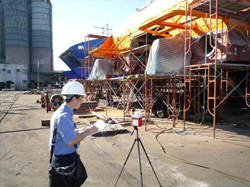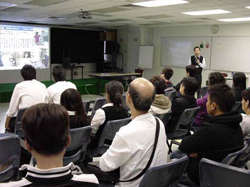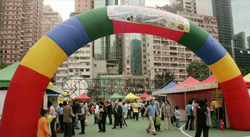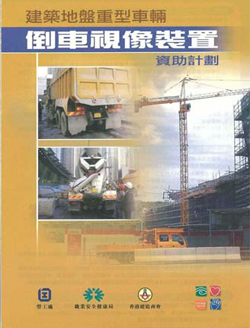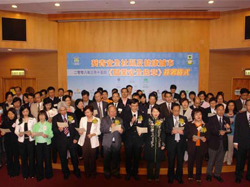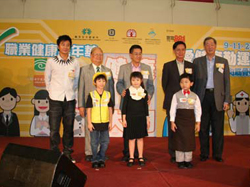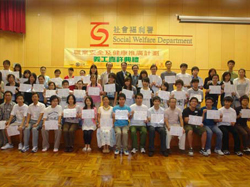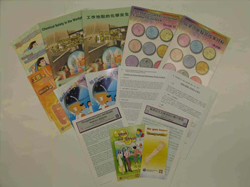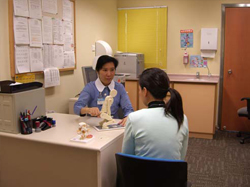Annual Report 2008
Chapter 4
Safety and Health at Work
The Programme of Safety and Health at Work
The Occupational Safety and Health Branch is responsible for the promotion and regulation of safety and health at work. The objective of the Programme of Safety and Health at Work is to ensure that risks to people's safety and health at work are properly managed and reduced to the minimum through the three-pronged strategy of legislation and enforcement, education and training, as well as publicity and promotion. More specifically, we achieve the objective by:
- providing a legislative framework to safeguard safety and health at work;
- ensuring compliance with the Occupational Safety and Health Ordinance (OSHO), the Factories and Industrial Undertakings Ordinance (FIUO), the Boilers and Pressure Vessels Ordinance (BPVO) and their subsidiary regulations by conducting inspections and taking out regulatory actions;
- investigating accidents and occupational health problems at workplaces;
- providing to employers, employees and the general public appropriate information and advice to promote knowledge and understanding of occupational safety and health; and
- organising promotional programmes and training courses to improve safety awareness of the workforce.
The Labour Department establishes the legislative framework to safeguard safety and health at work. The principal legislation for safety and health at work includes the OSHO, the FIUO, and the BPVO.
With few exceptions, the OSHO protects employees' safety and health at work in practically all branches of economic activities. It is basically a piece of enabling legislation that empowers the Commissioner for Labour to make regulations prescribing standards for general working environment as well as specific safety and health aspects at work.
The FIUO regulates safety and health at work in industrial undertakings, which include factories, construction sites, cargo and container handling areas, as well as catering establishments.
The BPVO aims at regulating the standards and operation of equipment such as boilers, pressure vessels, including thermal oil heaters, steam receivers, steam containers, air receivers and pressurised cement tanks mounted on trucks or trailers.
Our Work and Achievements is 2008
Work Safety Performance
Through the concerted efforts of all parties concerned, including employers, employees, contractors, safety practitioners and the Government, Hong Kong's work safety performance has been improving since 1998. The improvement in the construction industry was especially remarkable.
The number of occupational injuries in all workplaces in 2008 stood at 41 900, representing a drop of 28.8 per cent from 58 841 in 1999, while the injury rate per thousand employees decreased to 15.8, down by 34.9 per cent when compared to 24.3 in 1999. The number of industrial accidents and the accident rate per thousand workers also went down to 14 932 and 27.2 respectively, representing 58.5 and 50.7 per cent drop when compared to 35 986 and 55.1 in 1999.
The number of industrial accidents in the construction industry decreased from 14 078 in 1999 to 3 033 in 2008, a hefty drop of 78.5 per cent, while the accident rate per thousand workers also decreased from 198.4 to 61.4, down by 69.1 per cent.
Occupational Diseases
For more statistics on occupational safety and health, please visit the following webpage: www.labour.gov.hk/eng/osh/content10.htm
Key Indicators of Work
Some key indicators of work of this programme area are shown in Figure 4.1.
Enforcement
To ensure safety and health at work, we inspect workplaces, monitor health hazards, investigate work accidents and occupational diseases, register and inspect boilers and pressure equipment and advise on measures to control hazards or prevent accidents.
A key element in enforcement is to give advice on the prevention of accidents. We conducted promotional visits to encourage employers to adopt a proactive self-regulatory approach in managing risks at the workplace. We also conducted regular enforcement inspections to various workplaces to ensure that duty-holders had observed all related statutory requirements stipulated in safety legislation. In addition, we conducted 13 special blitz operations targeting at various high-risk work activities, including construction safety, safety of renovation and maintenance works, safety of tower cranes, safe operation of vehicles/mobile plant on construction sites, catering safety, cargo and container-handling safety as well as fire and chemical safety. Some of these blitz operations were conducted not only on normal working days but also at night and during holidays to detect and clamp down on offending contractors. In these 13 operations, a total of 32 117 workplaces were inspected, with 475 prosecutions initiated, 425 improvement notices and 59 suspension notices issued.
We continued to place establishments with poor safety performance under close surveillance. Improvement notices or suspension notices were issued when necessary to secure a speedy rectification of irregularities, or to remove imminent risks to lives and limbs. Many of these companies, especially those in the construction industry, have shown significant improvements in their safety performance. To handle workers' complaints on work safety more effectively, we established in April a Central Inspection Team to conduct independent investigation into complaints lodged by workers and encourage workers to report unsafe conditions or malpractices in workplaces. In the year, the team handled 115 complaints and initiated 10 prosecutions arising from investigation of these cases. We have also enhanced the intelligence reporting system on unsafe RMAA works with the Hong Kong Association of Property Management Companies. In 2008, a total of 526 enquiry/complaint/referral cases were received through the system and other channels. As a result of the inspections to follow up on these cases, 44 suspension/improvement notices were issued and 26 prosecutions were taken out. We established a similar referral mechanism with the Housing Department in May. By the end of the year, we received through the mechanism a total of 2 671 notifications of high risk RMAA works in housing estates and followed up on these referrals.
In the year, we conducted targeted inspections to food and beverage factories, vehicle repair shops, printing factories and other industrial establishments where chemical and ergonomics hazards were common to ensure adequate protection of the safety and health of workers. In these inspections, altogether 181 warnings and 15 improvement notices were issued. We also conducted regular inspections, including targeted inspection at night, to drainage maintenance worksites to ensure adequate protection of workers from gas poisoning, and to office workplaces and catering establishments to ensure that appropriate preventive measures were taken to safeguard employees from work-related musculoskeletal disorders.
The Commissioner for Labour, as the Boilers and Pressure Vessels Authority, recognises competent inspection bodies to assess and inspect new pressure equipment during manufacturing. As at the end of 2008, there were 31 appointed examiners and seven recognised inspection bodies. In addition, we conduct examinations, monitor courses for training of competent persons and issue certificates of competency to qualified candidates as competent persons for various types of boilers and steam receivers. In 2008, 420 applications for certificates of competency were processed, with 386 certificates issued/endorsed. At the same time, we advise the Fire Services Department on approval and preliminary inspections of pressurised cylinders and storage installations for compressed gas.
As at the end of 2008, a total of 176 171 workplaces, including 18 506 construction sites, were recorded. In the year, 111 866 inspections were conducted under the OSHO and the FIUO, while 4 706 inspections were made under the BPVO. As a result, 32 378 warnings were issued by Occupational Safety Officers while 2 988 warnings were given under the BPVO. Altogether, 1 416 suspension or improvement notices were issued. We also carried out 10 913 and 2 763 investigations on accidents and suspected occupational diseases respectively in the year.
Education and Training
To inculcate a culture of respect for occupational safety and health among the working population, we provide training-related services to employers, employees and stakeholders. Such services are divided into three categories - provision of training courses, recognition of mandatory safety training courses and registration of safety officers and safety auditors.
In 2008, we conducted 484 legislation-related safety and health training courses for 3 327 employees and 337 tailor-made talks for another 12 688. We also recognised eight mandatory basic safety training courses (commonly known as "green card" courses) for the construction and container-handling industries. As at year end, more than 994 000 persons have completed green card courses. In addition, we recognised three confined spaces safety training courses, two crane operator training courses, two gas welding safety training courses and two loadshifting machinery safety training courses. In December, the Commissioner for Labour withdrew the recognition given to a course provider for running two safety training courses for having violated the conditions granted for running the two courses concerned.
In 2008, 83 applicants were registered as safety officers while 35 applicants were registered as safety auditors. As at the end of the year, there were 3 076 registered safety officers and 952 registered safety auditors. Furthermore, we started to process applications for renewal and revalidation of registration as safety officers in September 2005. A total of 1 868 such applicants had been approved as at the end of 2008.
Occupational health education is one of the major strategies for the prevention of occupational health hazards and occupational diseases. Apart from organising health talks at our own offices, we also reach out to individual companies or organisations and deliver talks at their workplaces. In 2008, we organised a total of 1 404 health talks on various occupational health themes for over 42 800 participants.
Publicity and Promotion
We organised a series of promotional activities in 2008 to enhance the safety and health awareness of employers and employees, some in conjunction with other organisations such as the OSHC, trade associations, workers' unions and other government departments.
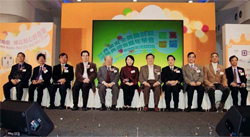
In anticipation of the growth of RMAA works, the Labour Department in collaboration with the OSHC, trade associations, workers' unions and other stakeholders, launched a two year territory-wide promotion campaign to publicise the safety of RMAA works and work-at-height. Major publicity activities included broadcasting "Announcements in the Public Interest" on television/radio, staging roving每exhibitions, publishing feature articles in newspapers and on the Labour Department website, publishing leaflets and disseminating safety messages to contractors, employees and employers through various means.
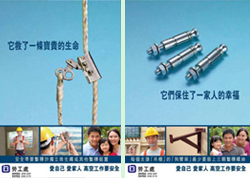
The Labour Department continued to operate jointly with the OSHC the Sponsorship Scheme for Fall Arresting Equipment for Renovation and Maintenance Work for SMEs and the Cut Resistant Gloves and Slip Resistance Shoes Sponsorship Scheme for SMEs. The former provides SMEs with financial assistance to acquire fall protection equipment and anchor device for use in work-at-height while the latter offers financial assistance to SMEs to purchase cut resistant gloves and slip resistant shoes for protecting frontline workers in catering establishments from cut and slip injuries.
In 2008, the Labour Department, OSHC and the Hong Kong Construction Association joined hands to launch a new sponsorship scheme, the Reversing Video Device Sponsorship Scheme for Heavy Vehicles on Construction Sites, to subsidise SMEs in the construction industry to install reversing video device on heavy vehicles, with a view to preventing accidents attributable to heavy vehicles reversing on construction sites.
The Occupational Safety Charter, launched jointly with the OSHC since 1996 to promote the spirit of "shared responsibility" in workplace safety and health, sets out a safety management framework for employers and employees to work together to create a safe and healthy working environment. By the end of 2008, 1 069 organisations, including public utilities companies, industrial and non-industrial establishments, banks, construction companies, unions, associations and community organisations, have subscribed to the Occupational Safety Charter.
Apart from promoting occupational safety, the Labour Department also promotes the prevention of occupational and work-related diseases through a multitude of activities such as health talks and seminars, educational video shows, publications, and "Announcements in the Public Interest". To protect the occupational health of office workers, we strengthened our publicity efforts in 2008 to promote the proper use of display screen equipment and the prevention of work-related musculoskeletal orders. This was achieved through video shows on mobile advertising media, occupational health talks and a self-learning educational video disc.
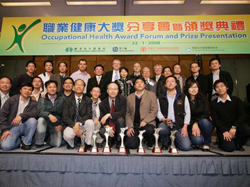
Under the Customer Service Teams Project, volunteers visited 19 407 catering establishments and SMEs of the retail and wholesale trades to disseminate safety messages to employers and employees in the year.
In 2008, we published 16 new occupational safety and health publications, including "Guidance Notes on Chemical Safety in Catering Industry", "An Analysis on Occupational Fatalities Casebook (Volume 4)", "Occupational Safety and Health Statistics Bulletin Issue No. 8 (May 2008)", "Guide on Shift Work", a series of booklets and leaflets on safety and health at work in relation to common diseases (e.g. Chronic Obstructive Respiratory Disease and Common Gastrointestinal Diseases) affecting the working population, and two guides on shift work and lighting assessment in workplaces respectively. Moreover, we also developed an educational kit for promoting the prevention of different occupational diseases.
To promote the safety awareness of the industry in operating boilers and pressure vessels, we reviewed, revised and edited a number of publications, including the "Code of Practice for Pressure Equipment Owners","Code of Practice for Thermal Oil Heaters", and "Brief on Accident Cases of Boilers and Pressure Vessels in Hong Kong". We also distributed 3 884 publications and leaflets regarding the safe operation of boilers and pressure vessels.
In 2008, the Occupational Safety and Health Branch handled 14 105 enquiries, advising on various safety and health matters. Furthermore, the Occupational Safety and Health Centre provides information and advisory services to workers and employers.
Clinical Occupational Health Services
The Labour Department runs occupational health clinics in Kwun Tong and Fanling, providing clinical consultations, medical treatment as well as occupational health education and counselling services for workers suffering from work-related and occupational diseases. The workplaces of the patients are inspected if necessary to identify and evaluate occupational health hazards in the work environment. We also assess the medical fitness for work of radiation workers, aviation personnel and government employees exposed to specific occupational health hazards.
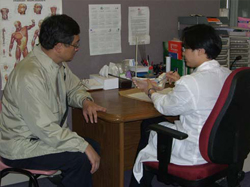
In 2008, 12 999 clinical consultations were rendered, and 3 070 medical examinations and assessments conducted. Moreover, six patient support groups were organised to promote patients' compliance with treatment and sustainability in good work practices through health talks, experience sharing and peer support.
